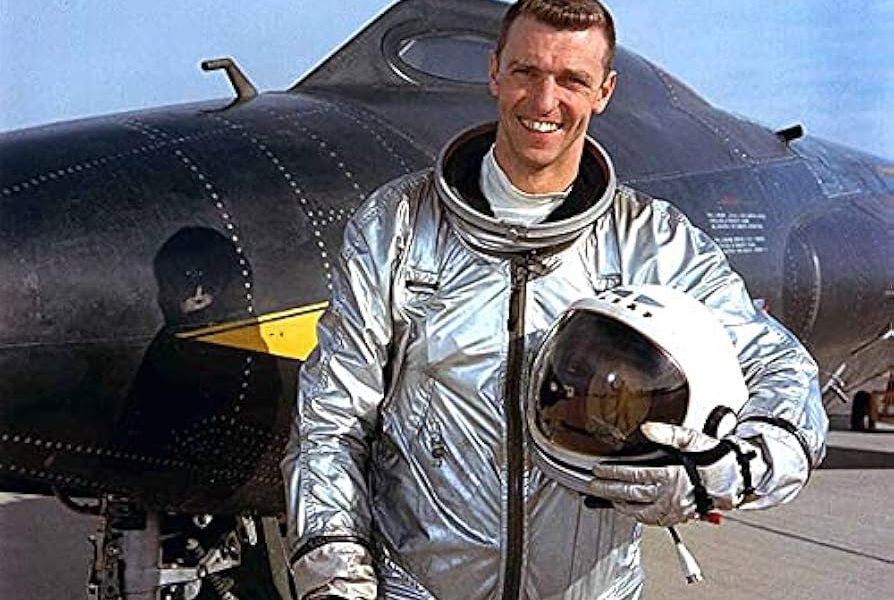Retired Air Force Maj. Gen. Joe Henry Engle, test pilot, Apollo-era astronaut, and the only American to fly two different winged vehicles into space, died July 10 at the age of 91.
Engle made 16 flights in the high-speed X-15 research aircraft; on three of those flights, he ascended above 50 miles, earning him astronaut wings. He flew approach and landing tests in the Enterprise shuttle prototype, and commanded two shuttle missions in space: the second shuttle flight, STS-2, aboard Columbia in 1981, and STS-51I, the 20th shuttle mission, which in 1985 deployed three commercial satellites from Discovery.
Engle flew more than 185 different aircraft—38 of them fighter/attack types—and amassed more than 15,000 flight hours, including 9,000 jet hours. At the time of his death, he was the last surviving X-15 pilot out of only 12 men to fly that craft.
Engle was born in Kansas in 1932 and earned a degree in aeronautical engineering from the University of Kansas in 1955, receiving a commission in the Air Force through the ROTC program there. While in college, he earned his private pilot license. In 1958, he won his Air Force wings and was assigned to fly the F-100 Super Sabre at George Air Force Base, Calif.
Just three years later, he graduated from the USAF Test Pilot School and was assigned to test fighter aircraft, including most of the Century Series fighters. Soon after, he was assigned to the Aerospace Research Pilot School. Engle was selected for the third NASA astronaut group, but the Air Force pulled his application because it wanted him for the X-15 program, to which he was assigned in 1963. In June 1965, he made his first flight above 50 miles and qualified for astronaut wings. His last flight in the X-15 was on Oct. 14, 1965, another suborbital space flight.
In 1966 he applied to NASA again and was chosen for the fifth group, becoming the youngest astronaut in the program and the only one to have previously flown in space.
In the Apollo program, Engle was the backup lunar module pilot for Apollo 14 and was selected to be the lunar module pilot on Apollo 17. When budget cuts eliminated the last three Apollo moon missions and it was clear Apollo 17 would be the last moon landing, NASA replaced Engle with Harrison Schmitt, a geologist, in order to get at least one scientist-astronaut on the moon. Engle accepted the decision gracefully and for his next assignment was offered a choice between the Skylab program, the Apollo-Soyuz test project, or the Space Shuttle. Engle chose the latter.
In 1977, Engle flew approach and landing tests on the Enterprise, NASA’s non-spaceworthy test shuttle built to explore approach-and-landing procedures. In those tests, the Enterprise was carried to 25,000 feet atop a 747 freighter and released to fly a dead-stick (unpowered) glide to landing, as would all subsequent shuttles.
Engle was the backup commander to John Young for the first shuttle mission, STS-1, and commanded STS-2, flying with pilot Richard Truly. The two-day mission in November 1981, was a second shakeout flight for the shuttle Columbia, and the first use of the “Canadarm” space crane/manipulator arm.
He later commanded STS-51I, with a crew of five, on a seven-day mission from August-September 1985 that included a 12-hour spacewalk for two of the crew to retrieve and repair LEASAT-3, a military communications satellite, and deployment of three commercial satellites.
While on astronaut flight status, Engle served as deputy associate administrator of NASA for manned spaceflight for most of 1982. He later participated in the investigation into the loss of the Challenger shuttle in 1986.
Throughout his NASA career, Engle retained his Air Force commission. His last Active-Duty assignment was as assistant to the commander-in-chief of North American Air Defense Command.
He retired from NASA on Nov. 28, 1986, and from the Air National Guard two days later, promoted to major general upon retirement. In retirement, he was a consultant to various government and corporate aerospace organizations and a technical advisor to NASA’s International Space Station Advisory Committee.
Gen. Kevin Chilton (Ret.) a three-time Shuttle astronaut who commanded STS-76 and later headed Air Force Space Command, told Air & Space Forces Magazine, “What I loved most about Joe was his willingness to share his knowledge and experience with anyone who would ask.” Chilton said he always had lot of questions for Engle “about his experiences in the X-15, and he would always patiently and excitedly answer them and more.” Chilton said Engle had the reputation of being “the best ‘stick and rudder’ man in the business,” and it is “no wonder that Joe uniquely was selected to hand-fly the Space Shuttle through re-entry on STS-2. He paved the way for all of us in the program.”
Engle’s extensive list of honors and decorations include the Defense and Air Force Distinguished Service medals; the Distinguished Flying Cross; two NASA flight medals; the NASA Exceptional Service Medal and NASA Special Achievement Award. The Air Force presented him the Gen. Thomas D. White Space Trophy. He received the American Institute of Aeronautics and Astronautics Pioneer of Flight Award; the Society of Experimental Test Pilots Iven Kincheloe Award; the Collier Trophy; Goddard Trophy and Harmon Trophy. He was elected to the U.S. Astronaut Hall of Fame, the Aerospace Pilot Walk of Honor and the International Space Hall of Fame. In 1964, he was named both the Air Force Outstanding Young Officer of the Year and one of the U.S. Junior Chamber of Commerce’s ten Outstanding Young Men of America. The University of Kanas awarded him its Distinguished Engineering Service Award.
Engle received the Air Force Association’s Lifetime Achievement Award in 2014.


